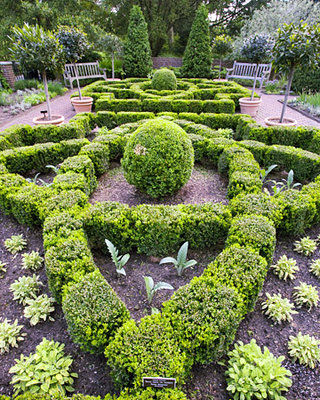
I’ve been reading a book called “Green Thoughts” by the late Eleanor Perenyi. She lived until the age of 91, passing away in 2009. Her 72 essays on gardening will live forever. She’s a hoot and her writing is delightful.
Right now, I’m enjoying the essay about herbs. Her insights couldn’t come at a better time. My small herb collection is growing like crazy, and I need ideas about how to use more of them and preserve the extras.
It’s easy to find space to grow your herbs. You don’t have to have a traditional knot garden for them. Make the most of a small, sunny garden by tucking them between established plants in a border or perennial bed. One of my favorite color combinations is purple and gold, so tricolor or purple sage mixed with golden oregano is right up my alley. Variegated lemon thyme is another colorful herb that fits right in.
When shopping for herbs, it’s a good idea to snip a leaf and crush it between your fingers. Smell the essential oil. You’d be amazed how different herbs can smell and taste, depending on the source of the plant.
Thyme can smell like caraway, pine, camphor, lavender or turpentine, and “these assuredly would be fatal to a bouquet garni,” according to Eleanor Perenyi. Rosemary plants can vary widely in taste, too. There are so many kinds available now, both upright and creeping, all originating from different stock. You don’t want to ruin chicken dinner by using the crushed leaves of one that tastes of pine or turpentine.
Trim your herbs often to keep them bushy and productive. Fresh herbs are at their finest in summer, when they peak in flavor and essential oils. Most herb stems can be cut and kept in a jar of water, out of direct sunlight, for a few days of use. I’ve even had basil send out roots in the water.
Gather herbs in summer and preserve them for the rest of the year, so you’ll always have some for flavoring.
Harvest your herbs properly
Most herbs should be harvested before the plants are about to bloom. That’s when the leaves are at their peak flavor and oils are strongest. Harvest on a sunny morning after the morning dew has evaporated. To fully harvest annual herbs such as basil, cut all stems back to just above the bottom two sets of leaves. Perennial herbs, such as sage, should be cut back to about a third of their height, also just above a set of leaves. As you collect your harvest, keep the cut stems out of the sun, or they will quickly wilt.
Some herbs with a high water content, such as tarragon, basil, chives, lemon balm, mint and dill, freeze well. Frozen herbs will keep their flavor for several months. Unlike dried herbs, whose flavor is more concentrated, frozen herbs can be used in the same proportion as fresh.
Dry other herbs by hanging stems in bundles or laying them on a shallow basket or screen. If drying on a screen or basket, remove large-leaved herbs from the stems before spreading them out. Smaller-leaved herbs, such as thyme, savory and rosemary, can be left on the stem to dry.
Herbs are dry when they crackle and crumble when rubbed between your fingers. Strip them from the stem and pack in labeled jars, because they tend to look alike when dried. Crushing the leaves releases their essential oils, so don’t do that until you use them.
Which herbs to grow
The five herbs I consider essential in the kitchen garden are basil, cilantro, oregano, rosemary and thyme. I also grow lemon verbena for tea, potpourri or sachets for my closet and drawers, and I grow lemon grass, which contains citronella oil, to help ward off mosquitoes.
You may choose herbs for salsa, tea or Italian dishes. Herbs can also be used in cosmetics, natural dyes, crafts and potpourri or used medicinally. Herb-flavored vinegar, tea, honey, butter, cheese, salt and sugar are other great ways to use your herbs. I like them all.
Jan Nelson, a landscape designer and California certified nursery professional at Plant Works in Ben Lomond, will answer questions about gardening in the Santa Cruz Mountains. E-mail her at ja******@*ol.com, or visit www.jannelsonlandscapedesign.com to view previous columns and pictures.











